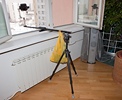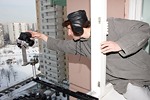Articles / Spherical panoramas night shooting using external pole
The shooting of "New York, I love you..." panorama was technically difficult and we have been planning it for several years. The idea itself came to us in 2007 after we had created such panorama with the help of such 4-meter pole. In January 2010 we chose time, arrived in New York and shot night sphere from the window of the Millennium Hotel.
There were several key difficulties.
The first one and the most obvious was a shooting out of the window with long exposures in darkness. We haven't seen the other examples of night shooting with an external pole in the Internet yet and we feel proud to do something for the first time in the world :)
The same shooting with the external pole is always made at day time because the pole with a camera swings from the wind with amplitude of 10-15 cm like an aspen leaf. And for that reason the short exposures are needed to take photos.
It is clear that it is impossible to realize such shooting in darkness as well as to stand a tripod out of the window. That is why we finally decided to set the tripod out of the window :)
Truly speaking, the tripod was in the room and a fastening system assured one and a half meter long bar which had been combined from two elements by RRS to be out of the window. In general, we actively use different kinds of RRS's objects in our work. Moreover, we can assure you that they make life easier and de facto became many photographers' standards.
| Bar made of two elements by RRS |
In order 5 kg construction (camera, object glass, panoramic head and fastening) wouldn't fly down together with the tripod we used a counterbalance consisted of 3 big Cola-Cola bottles. The bottles were put in a plastic bag and were hung on the bar inside the room.
The second difficulty was a depth of field. The field must be from 40 cm to infinity and we couldn't close a diaphragm much because of the long exposures. A focusing on hyperfocal distance resulted unsatisfactory. Besides, we couldn't put the camera further too because we needed to be able to handle it to rotate. Finally, we decided to use a method which is usually used in a landscape photography (well, we are actually the landscape photographers :)) and named "sharpness compensation". Speaking in brief, the city was shot with the focus on infinity but the room, our window and the closest windows of the hotel were shot with the focus on 1 m.
Next problem was the way how to take away all this bulky construction (external bar and tripod) from the shot, taking photos of a model standing in the window. To do it we measured the camera's position out of the window and, then, all the construction was transferred aside inside the room in order to empty the window. But, at the same time, the camera stayed in the same position out of the window keeping the same distance from the windowsill. The starting bar's position was drawn with a felt marker right on the windowsill in order the construction could be returned back then to the same position. Then the felt marker's traces were washed off with matrix cleaning liquid :)
| Standing in the window model shot with the bar transferred aside |
The camera was managed with the radio remote control which was fixed in the camera's hot shoe.
Another difficulty was a dynamic range of shooting scene. We had to adjust scene brightness out and inside the room to the camera's range. To realize it we manually calculated the exposure compensation for each shooting series and measured the utmost range points out and inside the room. We used HDR's techniques in fact.
We decided that we would shoot this sphere in high resolution using 16 mm fish-eye according to the following scheme: 6 shots going in circles and 3 shots to zenith using slim-rotator. It made our work more difficult because if we shot with low resolution (three shots using 10 mm fish-eye) many things would be easier and we would make much fewer efforts.
In the beginning we were going to shoot nadir (down view) too but if we rotated the camera down out of the window we would spend too much time. As a result, we refused to shoot nadir right in the process of taking photos, although the slim-rotator allowed doing this, and retouched it during processing.
We used the following equipment: camera Canon 1Ds MarkIII and objective Contax Carl Zeiss 16mm Fisheye adapted to Canon. First, we tried to shoot with old good "Fivy" (Canon 5D MarkII), but we discovered that exposure compensation range of "Fivy" (+/- two stops) wasn't enough for the scene shooting inside and out of the room. And as it was extremely inconvenient to change the exposition of every shot in the camera manually when it was hanging in the air at a half meter distance from the window and 120 meters from the ground, then we had to change the camera itself. Taking in consideration objective and other equipment the total amount of the hanging in the air construction was about $15'000.
And if we calculate Coca-Cola too, then it will be $15'003. But it's still not clear if we should calculate the costs for Coca-Cola because it was hanging inside the room :)
Just in case, the camera was corded with an armchair leg. We thought that even if our construction began to fell and pull the armchair, the armchair wouldn't go through the window anyway. So, we were completely ensured :)
One difficulty more supposed that all we mentioned above was necessary to do very fast because the shooting held in so named short "blue hour" when evening illumination is more attractive and changes very fast and the total sphere shooting cycle with exposure compensation and camera's rotation out of the window took about 5 minutes.
Before we left for New York a general rehearsal had been held. We constructed a test stand imitating the windowsill at the hotel and under local conditions made the corridor shooting running two of us around the camera which had been fixed on the external bar.
Many nuances appeared immediately. For instance, if first we make the whole construction and remove it out of the window then we can't hang the plastic bag with Coca-Cola as a counterbalance and it should be done beforehand :)
The list of shooting preparing operations occupied the whole sheet of paper like a Boeing pilots' check-list before a take-off. You can see the preparation steps, as well as the equipment needed, the allocation methods of camera and tripod with counterbalance in several photos below:
 |
 |
 |
 |
 |
| All the equipment used during the shooting | The whole construction ready for use | The last test before the shooting | Slim-rotator allowing not to shoot nadir | Bar's fastening to the tripod |
We had a not resolved till the end problem how to fix the spherical head with the camera to the bar out of the window. During the test, while rotating, the heavy construction right in my hands unexpectedly broke the duralumin bolt which had fastened the bar and the head.
Urgently we had to search for a substitute. Finally, a courier carried a new adapter for the fastening of the head to the bar to Sergey Semenov, who was going to fly to New York. The meeting of Sergey and the courier, transfer and demonstration of new equipment took place in the Airport Express train following from Paveletskaya railway station to Domodedovo Airport :)
Another one problem was the way how to get the needed room at the hotel with the view to Manhattan.
The hotel itself consists of two towers but for the shooting we needed only one side of the West Tower with a "right" view. We resolved that problem by making good relationship with a concierge who was reserving a room we needed on a desirable floor.
Sergey Semenov, who had to shoot this complicated panorama, had never shot spherical panoramas before and his attitude to them was skeptical enough. Though I saw with a heavy heart the way he left for New York, I hoped that everything would be fine because Sergey is an experienced photographer.
The shooting in New York took three days, but it's better to say - three evenings.
The files were sent to Moscow right after each photo-session to be immediately viewed and corrected if needed. And then the shooting went on including those amendments. Three spheres were made there, the first and the second are published. The third will be shown you a little later.



